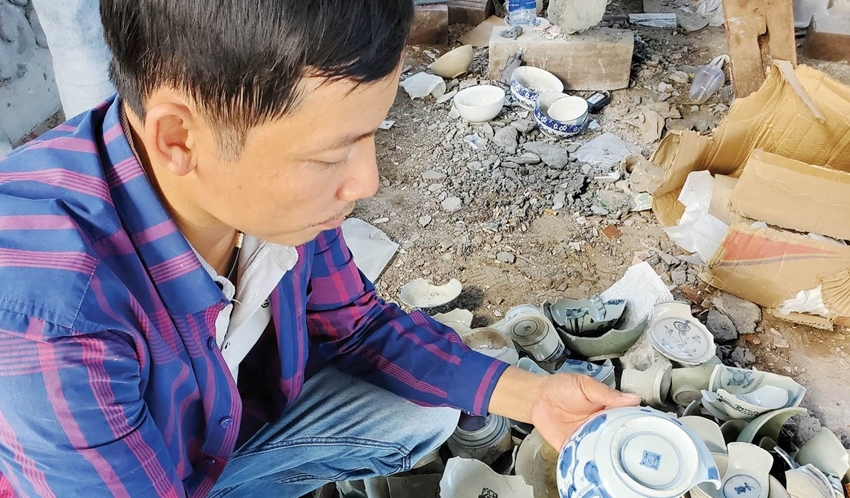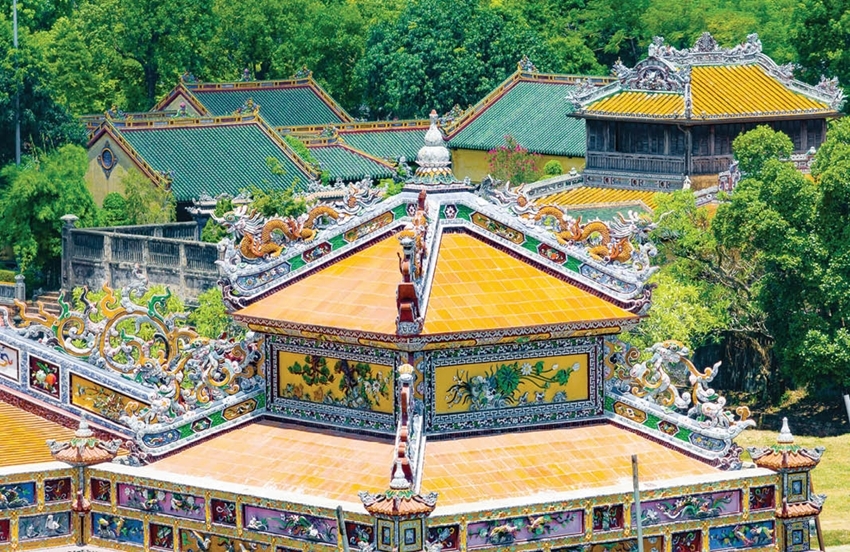 |
| Artisan Nguyen Thanh Thuan by the broken bowls purchased for the ceramic mosaic to restore dragons and phoenixes at Thai Hoa Palace. Photo: Bui Ngoc |
Gifted craftsmen
The artisans responsible for restoring the dragon, phoenix, and pattern decorations on the roof of the palace are ceramic mosaic artisans, known as as gifted craftsmen. Their work includes the factors: craftsmanship, meticulousness, and artistic gift.
Young artisan Nguyen Thanh Thuan (41, in Quang Tho Commune, Quang Dien District) is currently in charge of a team of nearly 20 highly skilled artisans, who undertake the work of shaping, inlaying ceramics, and restoring the decorative dragons and phoenixes on the roof of Thai Hoa Palace.
"Usually, a craftsman who wants to become an artisan must seek highly skilled masters with seniority and reputation to learn the craft. To be able to become a skilled craftsman, a student must study and work with the master for 3-5 years," artisan Nguyen Thanh Thuan shared.
However, the superb craftsmanship for major royal projects is often only handed down from father to son, and rarely is it passed down outside. It is especially even harder to find the skilled craftsmen responsible for inlaying ceramics to shape dragon and phoenix artworks on the roofs of palaces," Mr. Thuan added.
Artisan Nguyen Thanh Thuan has done ceramic mosaic work for the projects for monument restoration in Hue Ancient Capital since he was 18. So far, he has spent more than 20 years restoring dragons and phoenixes on Hue royal architecture. He was predestined to learn the ceramic mosaic craft through his master, artisan Truong Van An. This veteran artisan in ceramic mosaic in Hue undertook many projects for restoring dragons, and phoenixes, and decorating ceramic mosaics at restoration sites of Hue Ancient Capital over the past 30 years.
 |
| The majestic dragon and phoenix decorations on the roof of Kien Trung Palace were reinstated by the artisans after the project of restoration. Photo: Le Hoai Nhan |
“After finalizing my vocational training, I worked outside many times, but I didn’t know why I returned to work for the projects on Nguyen Dynasty monument restoration like a hard-to-break-with predestination. Working outside, despite the irregular work, the income was very high. For mausoleum works for the people in the coastal areas such as Phong Hai, Phu Thuan, Thuan An... and especially An Bang Village (Phu Vang), skilled craftsmen earn very high income, averaging 1 - 2 million VND per day. However, there is something very difficult to explain about doing psychical works: the income is high, but none of the craftsmen are rich. Many craftsmen often confide that whenever they have money, they also get into trouble to spend money, so their money is never ample despite their continuous labor," Mr. Thuan said.
"I also went to sea, but whenever I had money, I ran into trouble. Only when I return to work in the palace can I feel peaceful. Another reason why I am attached to the monuments is that for each ruined construction, after restoration, I look back at my works placed majestically on the roofs of the golden palaces, I feel really proud and happy," Mr. Thuan added.
“Working in monuments, craftsmen not only require superb craftsmanship but also must comply with strict conservation principles. Outside, craftsmen satisfy the homeowner's needs, so the products all meet... the homeowner's standards. Many graves sometimes required buying a ton of bowls, and those bowls were broken to create magnificent colorful dragons," Mr. Thuan added.
At Mr. Thuan's dragon and phoenix restoration workshop, currently, dozens of pairs of dragons are shaped with reinforced concrete and are being meticulously pieced together by artisans with bits of porcelain to embellish them into the artworks of dragons and phoenixes in accordance with the prototype on the roof of the palace. Aside from the new pairs of dragons being finalized, the pairs of century-old dragons on the roof of Thai Hoa Palace brought down are being modeled.
After shaping the pairs of dragons made of steel-reinforced concrete in accordance with the prototype, the artisans will start to "anatomize" the good ceramic pieces on the old dragon pairs to re-inlay them on the bodies of new dragon pairs. The missing part will be supplemented from tons of pieces of ancient ceramics purchased from those who specialize in salvaging ancient porcelain in the rivers of Hue and the Central Region.
“New ceramics cannot be used to inlay dragons and phoenixes in the monuments because of the color unsuitability. Most of the ancient ceramics used in the palace are from Japan and China, with a few from Europe. To have the source for restoring the monument, we have to order from sand workers on the Huong River. In the past, this source of ceramics was abundant, but now it becomes scarce, so for a sufficient source, we have to buy them back from antique collectors or seek porcelain at Japanese ceramics stores... at an exorbitant price,” Mr. Thuan said.
After the batches of crockery were purchased, the artisans broke them to get suitable pieces. Each piece of porcelain is meticulously glued together by artisans with cement. Day after day, the eyes, noses, legs, claws, and scales … are shaped, forming lively majestic pairs of dragons on the side of the palace roof.
Hue people’s unique creation
According to the research by author Ho Hoang Thao, the ceramic mosaic craft in Hue dated back to the 18th century. Initially, it was passed down during folk construction, but later became an art that served the royal court. The ceramic mosaic materials are selected from fragments of ancient ceramics, so raw materials are always scarce.
Nonetheless, the Perfume River bed had enough supply because, at that time, countless boats carrying items traveled on the Perfume River, and because Hue was the Royal Capital. Thanks to that large quantity of ceramics, the art in mausoleums, temples, pagodas, and places of worship in Hue has flourished, becoming an indispensable cultural feature in the Ancient Capital.
In the book “Phủ Biên tạp lục” (A series of 8 books recording the socioeconomic information of South and Central Vietnam from the late 16th century to 1776), author Le Quy Don describing Phu Xuan in the early 18th century also recorded the art of ceramic mosaic on buildings as follows: "...here the large magnificent palace, attics, roofs with the surrounding walls, doors on all four sides skillfully carved and painted ... The inner and outer walls were all built several meters thick, using lime and porcelain pieces to shape them into the forms of dragon, phoenix, unicorn, tiger, grass, and flowers...".
The ceramic mosaic art continued to flourish under the Nguyen dynasties. The Minh Mang and Thieu Tri dynasties also used this type of decoration. In the reign of Tu Duc, the ceramic mosaic became decorative. During the reign of Khai Dinh, ceramic mosaic decoration combined with colored glass flourished. The masonry lime ceramic mosaic decoration appeared in a series of architectural works, such as An Dinh Palace, Hien Nhon Gate, Chuong Duc Gate, Thai Binh Lau, Kien Trung Palace...
Gifted artisans have manifested the topics from the folk to the royal court: four sacred animals, eight treasures, sun and moon, twelve zodiac animals... Animals, plants close to life, and utensils of new-era features such as clocks, American lamps, and magnifying glasses... are also used for decoration. All are blended from fine pieces of ceramics imported from China and Japan with many beautiful precious colors such as orange and jade, and a new material, namely colored glass imported from France.
The Nguyen Dynasty ended its historical role in 1945, but the ceramic mosaic art in Hue has been passed down from father to son, like a typical decorative style of traditional and psychical construction. The ceramic mosaic art is a unique creation of the Hue people, offering a unique appearance to the architectural works of communal houses and temples in Hue.
The ceramic mosaic craft has been handed down and developed to serve the projects for monument restoration, reviving the noble majestic appearance of temples and palaces under the Nguyen Dynasty.